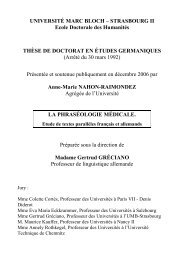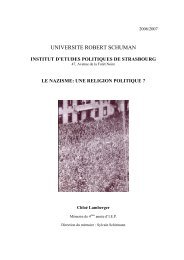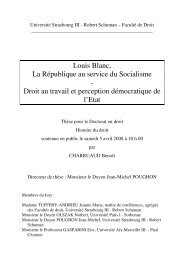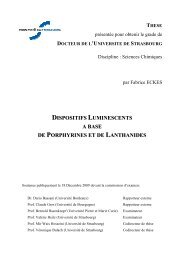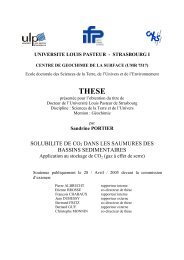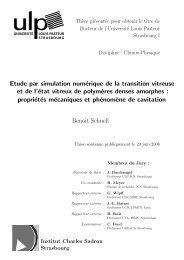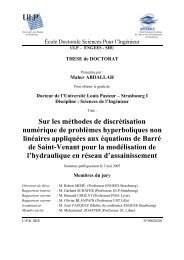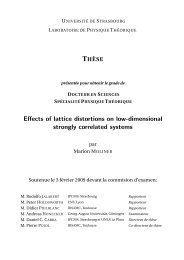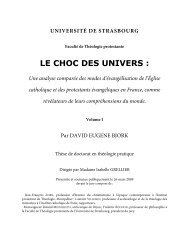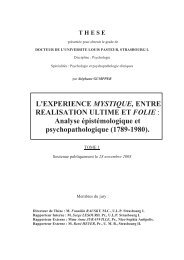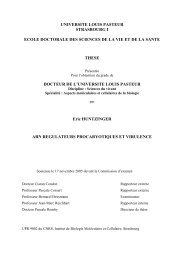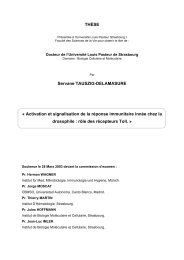Anthony KERMAGORET - THESES ET MEMOIRES DE L'UDS
Anthony KERMAGORET - THESES ET MEMOIRES DE L'UDS
Anthony KERMAGORET - THESES ET MEMOIRES DE L'UDS
Create successful ePaper yourself
Turn your PDF publications into a flip-book with our unique Google optimized e-Paper software.
Chapitre III<br />
by filtration. The solvent was evaporated, yielding pure PNth as a pale yellow powder. Yield: 7.03 g,<br />
68%.<br />
1 H NMR (CDCl3) δ: 3.25 (t, 2H, 3 JH-H = 8.4 Hz, SCH2), 3.32 (s, 2H, PCH2), 4.14 (tt, 2H, 3 JH-<br />
H = 8.4 Hz, 5 JH-H = 0.7 Hz, NCH2), 7.32-7.48 (m, 10H, aromatic). 13 C{ 1 H} NMR (CDCl3) δ: 34.6 (d,<br />
4 JP-C = 2.0 Hz, SCH2), 35.1 (d, 1 JP-C = 17.1 Hz, PCH2), 64.5 (s, NCH2), 128.5-137.6 (m, aromatic,<br />
PPh2), 167.7 (d, 2 JP-C = 12.2 Hz, C=N). 31 P{ 1 H} NMR (CDCl3) δ: -15.5 (s). Anal. Calcd. for<br />
C16H16NPS (285.34): C, 67.35; H, 5.65; N, 4.91. Found: C, 67.06; H, 5.94; N, 4.99.<br />
2.2 Preparation and Spectroscopic Data for [Ni(PNth)Cl2]4 (1a).<br />
0.73 g of solid 1b (see below) was dissolved in a minimum amount of CH2Cl2. To this,<br />
petroleum ether was quickly added (three times the volume of CH2Cl2). 1a precipitated as a pale<br />
green powder. Yield: 0.71 g, 98%.<br />
FTIR (cm -1 ) selected absorptions: 3071w, 3058w, 3038w, 3005w, 2984w, 2947w, 2932w, 2919w,<br />
2904w, 2887w, 20870w, 2859w, 2854w, 1603vs, 1585m(sh), 1572m, 1483s, 1434s, 1397w(sh),<br />
1382s, 1342w, 1324w, 1315w, 1277w, 1254m(sh), 1238s, 1190w, 1183w(sh), 1169w, 1159w,<br />
1137w, 1128w, 1100s, 1093s(sh), 1071w, 1028vs, 1024vs(sh), 1004m(sh), 984w(sh), 949m, 907w,<br />
862w, 853w, 841w, 827m(sh), 820m, 770m(sh), 764m(sh), 754m(sh), 739vs, 693vs, 690vs(sh),<br />
672m. Anal. Calcd. for C64H64N4Cl8Ni4P4S4 (M = 1651.8): C, 46.49; H, 3.90; N, 3.39. Found: C,<br />
46.13; H, 3.66; N, 3.40.<br />
2.3 Preparation and Spectroscopic Data for [Ni(PNth)Cl2] (1b).<br />
A solution of PNth (0.51 g, 1.8 mmol) in methanol (10 mL) was added to a solution of NiCl2<br />
(0.23 g, 1.8 mmol) in methanol (100 mL), resulting in a green reaction mixture. Stirring was<br />
continued for one hour at room temperature. The volatiles were removed under reduced pressure<br />
and the green solid obtained was left under vacuum for 12 h, yielding 1b as a red amorphous solid.<br />
Yield: 0.73 g, 1.75 mmol, 98%.<br />
FTIR (cm -1 ) selected absorptions: 3051w, 2986w, 2947w, 2905w, 2861w, 1603vs, 1483m, 1435vs,<br />
1386m, 1315w, 1275w, 1240s, 1189w, 1159w, 1100s, 1029vs, 1000w, 948w, 821w, 741vs, 693vs.<br />
ESI + : [M-Cl] + 377.9779 (calcd. For [C16H16NClNiPS] + : 377.9778). Anal. Calcd. for<br />
C16H16NCl2NiPS (M = 412.9): C, 46.49; H, 3.90; N, 3.39. Found: C, 46.07; H, 3.91; N, 4.23.<br />
2.4 Preparation and Spectroscopic Data for [Ni(PNox)Cl2]4 (2a).<br />
Complex 2b (1.20 g, 3.0 mmol, see below) was dissolved in a minimum amount of CH2Cl2.<br />
To this, petroleum ether was quickly added (three times the volume of CH2Cl2). 2a precipitated as a<br />
13



